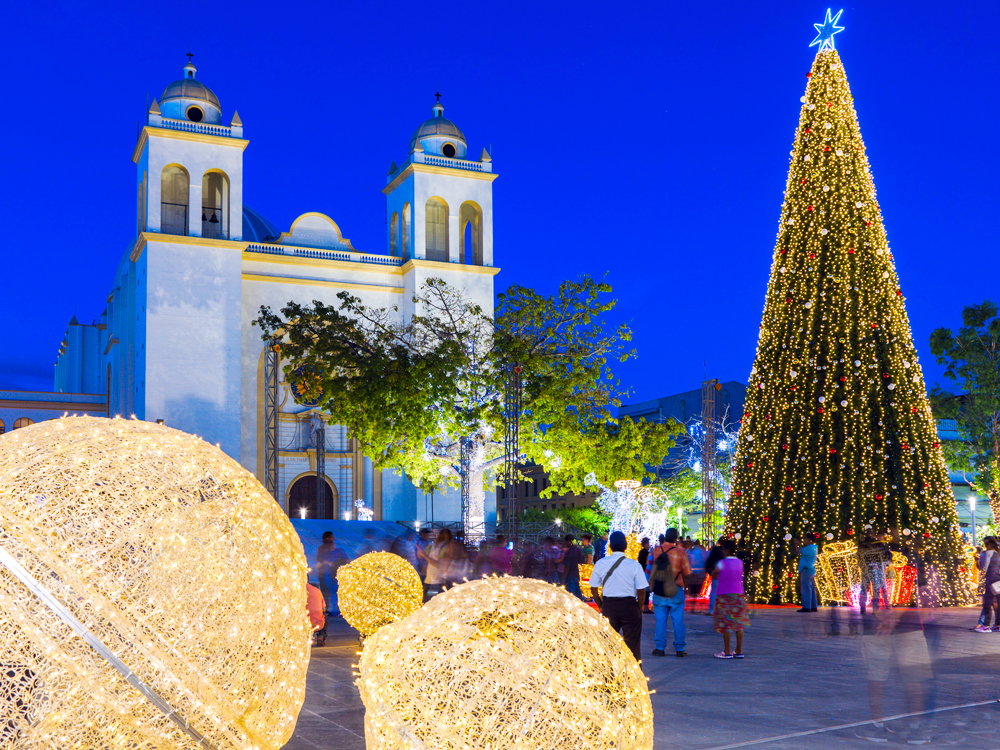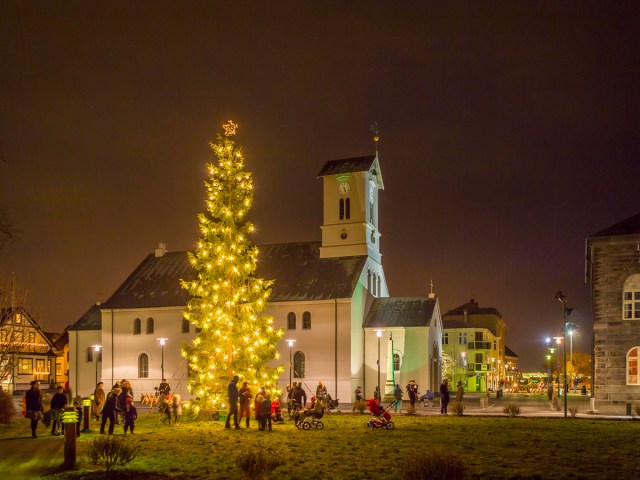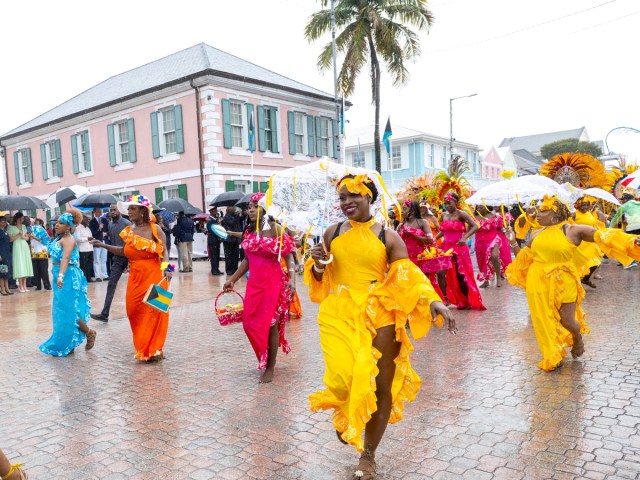If you grew up in the United States, you likely spent the holidays decorating a tree, baking cookies, and opening presents delivered by Santa Claus. But in other parts of the world, the Christmas holiday looks a little different. From presents brought to children by peculiar mountain men to massive fireworks displays, discover the fascinating Christmas traditions in 15 countries around the world.
Denmark

In Denmark, Christmastime is filled with particularly festive parties called julefrokost. The Danish word jul translates to “yule,” the winter solstice celebration from which many Christian traditions have been derived. Technically, julefrokost means “Christmas lunch,” but that doesn’t stop these events from lasting all day and into the night. Friends, family members, and colleagues host parties throughout the month of December, and each gathering includes several courses of food and an abundance of alcoholic beverages.
Similar to their Scandinavian neighbor, Norway celebrates Christmas with a festive meal called julebord, and Sweden has julbord, both of which translate to “Christmas table.” These gatherings occurs nearly every weekend leading up to Christmas, as groups of friends and family members come together to celebrate throughout the season.
El Salvador

There are two Christmas traditions that Salvadorans take very seriously: fireworks and nativity scenes. Throughout the entire month of December, many people in El Salvador light fireworks in anticipation of the upcoming holiday. On Christmas Eve, a traditional firework display takes place right before midnight, with people lighting them across the country. Nativity scenes, or Los Nacimientos, are also hugely important to Christmastime in El Salvador. Families may spend days constructing scenes in their front yards — some are so elaborate that they feature water fountains or light shows.
The Netherlands

St. Nicholas, known as Sinterklaas, is an important figure in the Netherlands. On December 5, the eve of St. Nicholas’ birthday, many businesses and shops close to celebrate St. Nicholas Eve with feasts and gatherings, and children put their shoes in front of the fire to receive gifts from Sinterklaas himself. The Dutch have participated in this celebration for at least 700 years, in honor of the fourth-century bishop who was the patron saint of children. Today, legend has it that Sinterklaas lives Sin Spain, and he travels to the Netherlands every year by steamship.
The Philippines

As the only predominantly Christian nation in East Asia, the Philippines goes all out for the holiday. Filipinos prepare for Christmas throughout December by constructing elaborate and decorative lights outside their homes and businesses. The culmination of the holiday fervor occurs in San Fernando with the Giant Lantern Festival, where intricate lanterns, called parols, are built to represent the Star of Bethlehem. The tradition stemmed from creating lanterns to light Christmas Eve mass but morphed into the massive structures seen today, which are illuminated by thousands of light bulbs.
Sweden

One of the most popular Christian traditions in Sweden falls on December 13. Known as St. Lucia’s Day or St. Lucy’s Day, it was named for a young Christian girl who was killed for her faith in 304 CE. St. Lucia used to wear candles on her head, so that she could carry food to persecuted Christians throughout Rome. On St. Lucia’s Day, young girls throughout Sweden wear white robes with a red sash, donning a crown of candles atop their heads to honor the young martyr. Boys also get in on the fun, dressing up as stjärngossar (star boys), tomtar (gnomes), or gingerbread men.
Brazil

The Christmas season evokes visions of snow-covered winter wonderlands for many Americans, but in the Southern Hemisphere, Christmas is a summertime holiday. In Rio de Janeiro, Brazil, Christmas feels more like the Fourth of July as fireworks accompany the annual lighting of the floating Christmas tree surrounded by the waters of Rodrigo De Freitas Lagoon. The Guinness Book of World Records has deemed it the world’s largest floating Christmas tree. Measuring 278 feet tall, the tree is decorated with more than 3 million lights, with multiple changing lighting displays as it floats to different parts of the lagoon.
Christmas in Brazil also centers around Missa do Galo, which translates to “Rooster Mass.” This church service, which takes place at midnight, is named for the rooster because the bird is responsible for calling out the new day. Brazil also believes in a version of Santa Claus, called Papai Noel, who wears a suit of red silk to stay cool in the heat. Brazilian children put a sock on their windows to trade for a gift from Papai Noel, while adults prefer Amigo Secreto — the Brazilian version of Secret Santa — for their gift exchange.
Poland

During Advent, the weeks leading up to Christmas, people in Poland are encouraged to practice moderation. As in Lent before Easter, Polish people abstain from anything excessive, choosing to give up their favorite foods or alcohol in preparation for Christmas. They also spend the month of December cleaning their homes and washing carpets, so everything can be sparkling on Christmas Day. When Christmas Eve, known as Wigilia, finally arrives, families eat 12 dishes for 12 months of good luck. However, no one is allowed to eat until the first star is spotted in the sky.
New Zealand

From November until late December, Santa parades are popular throughout New Zealand, although naturally, the Kiwi version of Santa wears sandals and a rugby shirt. On Christmas Eve, instead of milk and cookies, Santa usually receives a beer and some pineapple chunks, and carrots are left out for the reindeer. In addition to a traditional fir Christmas tree, Kiwis also decorate with flowers from the Pōhutukawa tree, which is a native plant nicknamed the “Christmas tree” for its red flowers that bloom in December.
Finland

Finnish people have an unusual way of celebrating Christmas — a nice, long, sweat in the sauna. Christmas sauna, or joulusauna, as it’s called in Finland, has been a tradition here for centuries. Historically, the idea stemmed from the sauna being a way to purify the body and clear the mind before the arrival of Finnish spirits, elves, and gnomes. To do otherwise would anger the mythical beings, who were believed to enjoy the sauna on the holiday. Today, this tradition occurs on the afternoon of Christmas Eve, as a way to relax before the festivities.
Iceland

Children in Iceland receive Christmas presents from the Yule Lads, a group of 13 mischievous pranksters who live in the mountains and descend upon towns for 13 nights before Christmas. On each of the 13 nights, children leave shoes on their windowsill, and the Yule Lads distribute candy or rotten potatoes, depending on whether the children have been naughty or nice. Each lad has a persona for which he is known, like Þvörusleikir (Spoon Licker) Bjúgnakrækir (Sausage Swiper), and Gluggagægir (Window Peeper).
Icelanders are voracious readers, too — there are more books read here per capita than anywhere else in the world. Christmas traditions draw on the Icelandic love of books, with Jolabokaflod — or “Christmas book flood” — inviting families to wrap themselves up in a blanket with a mug of hot chocolate and get lost in a good book.
Jamaica

As Jamaica is part of the British Commonwealth, Boxing Day on December 26 is an official national holiday in the Caribbean island nation. This dates back to the 17th century, when plantation owners allowed enslaved peoples a break on the day after Christmas. In their free time, they would dance all night to live drumming, often dressed in masks. This celebration evolved into Jonkonnu, which is a time-honored Jamaican tradition around Christmastime. Today, Boxing Day features Jonkonnu parades with masked dancers and live drummers in the street.
Germany

Christmas is a big deal in Germany — it’s widely believed that practice of decorating Christmas trees originated here. One way Germans love to celebrate Christmas is by making a fiery version of mulled wine. Feuerzangenbowle (Fire Tong Punch) is a festive drink that is served at holiday parties throughout the country. Prepared in a specialized fondue pot, the punch is made by lighting a rum-soaked sugar cube over the hot drink — hence the name “Fire Tong.” The recipe became popular after the release of the 1943 comedic movie Feuerzangenbowle — now, it is a customary holiday tradition to prepare the punch with friends before watching the beloved film.
Colombia

In Colombia, the Christmas season starts with Día de las Velitas, or Little Candles’ Day. The holiday takes place on December 7, which in the Catholic tradition is known as the Eve of the Immaculate Conception. Colombians celebrate Día de las Velitas by placing candles and paper lanterns on windowsills and balconies. Most also partake in novenas, between December 16 and Christmas Eve, when family members and friends congregate to recite traditional Christmas prayers called Novenas de Aguinaldos. It’s also a time to convene with loved ones, sing carols, and eat holiday dishes.
Canada

“Mummering” is an eccentric holiday tradition that is celebrated in small towns throughout the Canadian province of Newfoundland and Labrador. To partake in the Christmas pastime, people called “Mummers” dress up in disguises, donning silly masks or clothing, before knocking on the doors of friends. If the host invites them in, an impromptu party occurs, with cake, beverages, and dancing. If the host cannot accurately guess the Mummers, then they are required to dress up and join the Mummering festivities for the rest of the evening.
Spain

Spain holds a special Christmas lottery that is drawn annually on December 22. Called El Gordo, which translates to “the fat one,” the tradition is one that most Spaniards partake in — likely due to the billion-dollar jackpot. Indeed, the Christmas lotto often turns into a national frenzy — many people share a lotto ticket with friends, family, or co-workers, choosing to split the jackpot should they win. The lotto numbers are drawn from a giant ball and announced to much fanfare on television, with school children singing the winning numbers.
More from our network
Daily Passport is part of Inbox Studio, which publishes content that uplifts, informs, and inspires.























